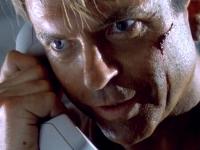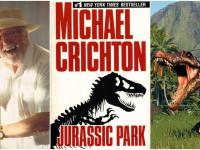Jurassic Park: All 6 Dinosaurs That Appear In The First Movie Explained

The first movie in the Jurassic Park franchise includes a half-dozen different dinosaur species. Here's a breakdown of each and every one.
Here's a breakdown of all the different dinosaur species featured in the first Jurassic Park movie. Since the earliest days of cinema, filmmakers have always had a fascination with the terrible lizard, and understandably so: the prehistoric reptiles lend themselves to all manner of big screen spectacle. Going back to their appearances in Winsor McCary's 1914 animated short Gertie the Dinosaur and D.W. Griffith's live-action Brute Force (which premiered the same year), dinosaurs were commonly portrayed as mindlessly blood-thirsty monsters in the beginning, especially in black and white classics like King Kong. It wasn't until decades later that dinosaurs were depicted in a more empathetic light, particularly in animated movies like Don Bluth's The Land Before Time.
Released in 1993, Steven Spielberg's adaptation of Michael Crichton's best-selling sci-fi novel Jurassic Park not only brought dinosaurs to life in live-action with heretofore-unseen realism, it also showed how they could be both terrifying and majestic, often at the same time. The film was a massive success across the board, becoming the highest-grossing movie ever at the time of its release and winning the favor of critics with its story of scientific hubris and the power of creation. It's since given rise to a multi-billion dollar franchise spanning multiple installments, including a sequel trilogy set to conclude with the upcoming Jurassic World: Dominion.
In light of the property's expanding scale and scope, it's easy to forget the original Jurassic Park only includes appearances by a half-dozen dinosaurs, and some of them only show up in a single scene. Today, we're running down all six species and the roles they play in the movie's plot.
Velociraptor

There are few dinosaurs more closely associated with the Jurassic Park franchise than the Velociraptor, an extremely cunning carnivore capable of doing everything from learning how to open doors to (as seen in the Jurassic World trilogy) following commands from humans, if trained correctly. In truth, the version of the Velociraptor featured in both the first Jurassic Park book and movie was primarily based on another member of the dromaeosaurid family, the Deinonychus, in terms of both their physical appearance and behavior. They also lack the feathers Velociraptors are now known to have, while still possessing the creature's infamous sickle-shaped claw for hunting.
It's the Velociraptors that actually set the plot for Jurassic Park the movie in motion. When one of them kills a park employee while being transported to their holding pen, the park's investors demand the park be inspected by a group of scientific experts who can weigh in on its safety (or lack thereof). Because the raptors are too dangerous to be kept outside of their heavily-fortified enclosure, they're stuck in their pen when the rest of the park's security facilities are shut-down by the park's head computer programmer, Dennis Nedry, in an act of industrial sabotage. However, when the park's entire security system is later turned off in order to be rebooted, it gives the deadly creatures the opportunity to escape and spend the third act hunting the movie's heroes.
Brachiosaurus

One of the many things people love about Jurassic Park is the way it takes the time to capture the splendor and awe of dinosaurs (when it's not making them seem absolutely terrifying, that is). There may be no better example of this than the iconic scene where Dr. Grant, Sattler, and Malcolm get their first glimpse of a living, breathing dinosaur in the form of the herbivorous Brachiosaurus. The gentle creature offers a reprieve from the action later on during the movie, when Grant, Tim, and Lex encounter one of them after spending the night in a treetop, as well as some light-hearted comedy when it sneezes upon an unsuspecting Lex. Standing at a height of upwards of 70 feet (with a disproportionately long neck) and weighing as much as 64 short tons, one imagines most people would be just as wonder-struck seeing one of them in real-life.
Triceratops

Considering how prevalent and popular the herbivorous Triceratops is in pop culture, it's no wonder dino-fanatics were aghast when a study was published in 2010, claiming the dinosaur was really just a less mature version of the ceratopsid Torosaurus. The claim was subsequently disputed based on additional evidence, so the reputation of everyone's favorite three-horned, four-legged, plant-eating dino remains intact to this day. As for the creature's importance to Jurassic Park: the movie's heroes famously encounter a sick Triceratops during their tour of the titular park, making it the only dinosaur they actually see on the tour. It's a quietly-moving scene (particularly when Grant lies his head upon the creature's side as it breathes) and a good reminder that dinosaurs are more than just unfeeling eating machines.
Tyrannosaurus Rex

Outside of the Velociraptor, the carnivorous Tyrannosaurus rex is probably the dinosaur many people think of first when Jurassic Park is brought up. A bipedal meat eater with (seemingly) disproportionately small forelimbs, the T-rex is believed to have had the strongest bite force among terrestrial animals in real-life, and is certainly talented at chomping down on things in Spielberg's movie. The film plays fast and loose with what the actual T-Rex could and couldn't do (see also: when Grant famously claims the creature's vision is based on movement), and the debate about whether they were a predator, scavenger, or both rages on. For the purposes of Jurassic Park, however, the T-Rex is very much a fan of hunting its food, as Grant observes at one point.
Interestingly, from a storytelling perspective, the T-Rex has always walked the line between acting as an antagonist and ally to the humans in the Jurassic Park franchise. This all goes back to the original movie, where the T-Rex initially breaks loose (after the park's security facilities are turned off) and kills the lawyer Donald Gennaro, severely injures Malcolm, and nearly eats Grant, Lex, and Tim. Towards the very end of the film, though, the creature comes to Grant and the other's aid by attacking two of the remaining Velociraptors, just as they're about to have themselves a human sandwich. It's a great plot twist and set the stage for the T-Rex to act as a chaotic neutral force in the many sequels to come.
Dilophosaurus

As cool as the Dilophosaurus' ability to spit venom and expand a cowl around its neck are in Jurassic Park, the actual dinosaur couldn't do either of those things. The real Dilophosaurus was nevertheless a carnivore like its onscreen counterpart, and is believed to have been one of the first large predatory dinosaurs on the North American continent when it was alive (with a slender build close to 25 feet in length and weight approaching 900 pounds). In Spielberg's movie, the dinosaur is a no-show on the heroes' tour, only to pop up later when Nedry crashes his vehicle while trying to flee the island, and proceeds to spit venom in his eyes before eating him alive. It's one of the most horrifying sequences in the entire film - and a scene that shows why it's good to take creative liberties sometimes.
Gallimimus

Out of the all the dinosaurs that make an onscreen appearance sometime during Jurassic Park, the Gallimimus probably has the smallest impact on the story. That's not to say the one-off scene where Grant, Lex, and Tim encounter a herd of the creatures is unimpressive or pointless. Far from it, it's an exciting moment where the speedy bipedal dinosaurs (which were probably some of the fastest dinosaurs, capable of running up to 30 miles per hour, and believed to be omnivores that subsisted on things like smaller animals and insects) nearly trample over the heroes in their efforts to flee the T-Rex, who still manages to catch and snack on one of them. But more than being a showcase for some then cutting-edge CG effects, it's an encounter that reminds Grant and the others to get a move on and find their way the heck off Isla Nublar already.
Source: https://screenrant.com/








